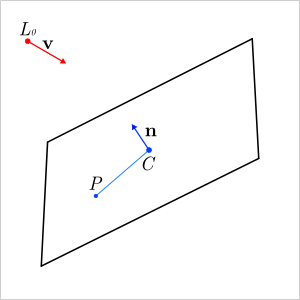Enrico Gullotti
earnest wonderer
earnest wonderer

\( C \) = Point defining the plane position
\( n \) = Vector normal to the plane
\( P \) = Point on the plane
\( L_{0} \) = Point on the line
\( \mathbf{v} \) = Vector that defines the line direction
\( n \) = Vector normal to the plane
\( P \) = Point on the plane
\( L_{0} \) = Point on the line
\( \mathbf{v} \) = Vector that defines the line direction
Parametric equation of the line A generic line defined by a point \( L_{0} \) and a direction vector \( \mathbf{v} \). It describes all the points along the line as a function of the parameter \( t \). \[ L_{\left( t \right)} = L_{0} + t \mathbf{v} \] Intersection calculation To calculate the intersection between plane and line, substitute the generic point \( P \) on the plane with a generic point on the line \( L_{ \left( t \right) } \). \[ \left( L_{0} + t \mathbf{v} - C \right) \cdot \mathbf{\hat{n}} = 0 \] Apply the distributive property of the dot product. \[ \left( \mathbf{v} \cdot \mathbf{\hat{n}} \right) t + \left( L_{0} - C \right) \cdot \mathbf{\hat{n}} = 0 \] Solve for \( t \). \[ t = \frac{ - \left( L_{0} - C \right) \cdot \mathbf{\hat{n}}}{\left( \mathbf{v} \cdot \mathbf{\hat{n}} \right)} \] Intersection points Depending on the values of numerator and denominator of the solution there can be one or no intersections:
- if \( \left( \mathbf{v} \cdot \mathbf{\hat{n}} \right) \neq 0 \)
There is one intersection at: \[ L_{int} = L_{0} + t \mathbf{v} \] - if \( \left( \mathbf{v} \cdot \mathbf{\hat{n}} \right) = 0 \)
The line is parallel to the plane. - if \( \left( L_{0} - C \right) \cdot \mathbf{\hat{n}} \neq 0 \)
The line does not lie on the plane, there are no intersections. - if \( \left( L_{0} - C \right) \cdot \mathbf{\hat{n}} = 0 \)
The line lies on the plane, there are infinite intersections.